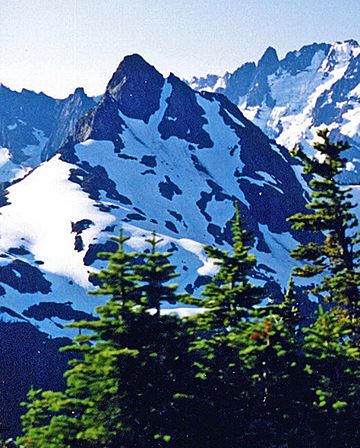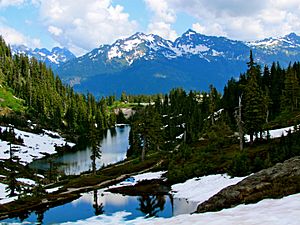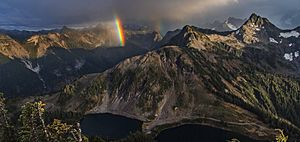Goat Mountain (Whatcom County) facts for kids
Quick facts for kids Goat Mountain |
|
|---|---|

Goat Mountain from Winchester Mountain Lookout
|
|
| Highest point | |
| Elevation | 6,844 ft (2,086 m) NAVD 88 |
| Prominence | 1,599 ft (487 m) |
| Isolation | 2.75 mi (4.43 km) |
| Parent peak | Mount Chardonnay (7,020 ft) |
| Geography | |
| Location |
|
| Parent range | Cascade Range North Cascades |
| Topo map | USGS Mount Larrabee/Mount Sefrit |
| Type of rock | Darrington Phyllite |
| Climbing | |
| First ascent | 1904, Frank Calkins and George Otis Smith |
| Easiest route | Scramble |
Goat Mountain is a tall peak in Washington state. It stands 6,844 feet (about 2,086 meters) high! This mountain is part of the Skagit Range, which is a smaller section of the larger North Cascades mountain range.
You can find Goat Mountain in the Mount Baker Wilderness. This special area is looked after by the Mount Baker-Snoqualmie National Forest. To its south is Mount Shuksan, and to its north is Mount Larrabee. Goat Mountain even has a slightly smaller peak next to it, called the west peak, which is 6,725 feet high. There are also tiny bits of an old glacier on its northern side.
The closest taller mountain is Mount Chardonnay, about 2.75 miles (4.4 km) to the east. Long ago, in the 1940s, there was a place called the Silver Tip Mine on the mountain's south side. People mined for silver and gold there! Water that falls on Goat Mountain eventually flows into big rivers like the Fraser River and the Nooksack River.
Weather and Climate Around Goat Mountain
Goat Mountain is in a "marine west coast" climate zone. This means it's near the ocean, which affects its weather. Most of the weather systems start over the Pacific Ocean. They then travel northeast towards the Cascade Mountains.
When these weather systems hit the tall Cascade Mountains, they are forced to rise. This process is called orographic lift. As the air rises, it cools down and drops its moisture. This is why the western side of the North Cascades gets a lot of rain or snow, especially in winter. The snow here tends to be wet and heavy because of the ocean's influence. This can sometimes lead to a high risk of avalanches.
Because it's close to the Pacific Ocean, the area around Goat Mountain rarely gets extremely cold or hot. Temperatures usually stay between 0°F (-18°C) and 80°F (27°C). Winters are often cloudy. However, during the summer, high-pressure systems over the Pacific Ocean bring clear skies. The best time to visit or climb Goat Mountain is usually from July through September, when the weather is most pleasant.
How Goat Mountain Was Formed
The North Cascades mountains, where Goat Mountain is located, have very rugged and dramatic landscapes. You'll see sharp peaks, long ridges, and deep valleys carved by glaciers. These amazing features were created by geological events that happened millions of years ago.
The story of the Cascade Mountains began millions of years ago, during a time called the late Eocene Epoch. The North American Plate (a huge piece of Earth's crust) was slowly moving over the Pacific Plate. This movement caused a lot of volcanic activity. Also, smaller pieces of Earth's crust, called terranes, came together to form the North Cascades about 50 million years ago. The rocks that make up Goat Mountain are a type called Darrington Phyllite.
Even more recently, over the past two million years, huge sheets of ice called glaciers moved across the land many times. As they advanced and retreated, they scraped and shaped the landscape. This is why many river valleys in the area have a "U"-shape. The combination of the land being pushed up (called uplift) and cracks forming in the Earth's crust (called faulting), along with the power of glaciers, created the tall peaks and deep valleys we see in the North Cascades today.
Images for kids
-
Goat Mountain from Winchester Mountain Lookout








